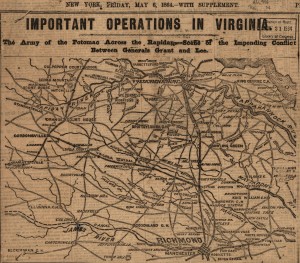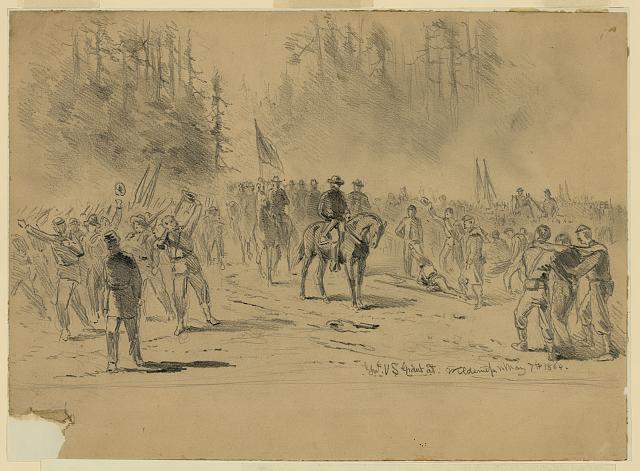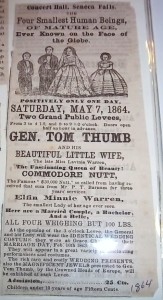In his 1920 memoirs William Meade Dame remembered that his unit, the Richmond Howitzers, were bystanders and observers during the Battle of the Wilderness. However, 150 years ago tonight, they were in the vanguard as General Lee raced to get his forces to Spotsylvania Court House ahead of the federals.
From From the Rapidan to Richmond and the Spottsylvania Campaign by William Meade Dame, D.D. (pages 93-97):
The Battle of the Wilderness was done. Grant was pinned into the thickets, hardly able to stand Lee’s attack, no thoroughfare to the front and twenty odd thousand of his men dead, wounded and gone. That was about the situation when dark fell on the 6th of May!
That night we drew off some distance to the right, and lay down, supperless, on the ground around our guns; it was very dark and cloudy and soon began to rain. There had been too much powder burnt around there during the last two days for it to stay clear. And so, as it always did, just after heavy firing, the clouds poured down water through the dark night. Lying out exposed on the untented ground, with only one blanket to cover with, we got soaking wet, and stayed so.
The comfortless night gave way, at last, to a comfortless day—May 7th—gloomy, lowering, and raining, off and on, till late in the evening. During the morning, a little desultory firing was heard in front, and then all was quiet and still. We knew enough to know that Grant’s push was over at this point. Some of us had gone up to look at the ground over which Longstreet had driven the enemy yesterday. We knew that the Federal troops could never be gotten back over that awful, corpse-covered ground to attack the men who had driven them. We knew we had to fight somewhere else, but where? By and by, talk began to circulate among the men that Spottsylvania, or around near Fredericksburg, might be the place. Of one thing we were all satisfied, that we would know soon enough.
In this waiting and excited state of mind, the long, long, rainy day wore on, and dark fell again. We had managed to conjure up some very lonesome looking fires out of the wet wood lying about (fence rails were not attainable here in the wilderness), and were engaged in a hot dispute about where the next fighting was to be, which warmed and dried us more than the fires did, when “the winter of our discontent” was made “glorious summer,” so to speak, by the news that the wagons had got up, and they were going to issue rations. Tom Armistead made this startling announcement in as bland, and matter of course a tone as if he were in the habit of giving us something to eat every day, which he was not, by a great deal. …
The present rations were quickly distributed, and as quickly devoured, and not a man was foundered by over-eating! Then we sat around the fires and discussed the news that had been gathered from various sources. …
It was just ten o’clock and each man was looking around for the dryest spot to spread his blanket on, when a courier rode up, with pressing orders for us to get instantly on the march. In a few moments, we were tramping rapidly through the darkness, on a road that led, we knew not whither. We were, as we found out afterwards, leading the great race, that General Lee was making for Spottsylvania Court House to head off Grant in his efforts to get out of the Wilderness in his “push for Richmond.” We were with the vanguard of the skillful movement, by which Longstreet’s Corps was marched entirely around Grant’s left flank, to seize the strong line of the hills around Spottsylvania Court House and hold it till the other two Corps could come to our aid.
We marched all night, a hard, forced march over muddy roads, through the damp, close night. Soon after the start from our bivouac, a brigade of infantry had filed into the road ahead of us, and we could hear, behind us on the road, though we could not see for the darkness, the sound of other troops marching. The Brigade ahead of us, we soon found, to our gratification, to be Barksdale’s Mississippi Brigade, now under command of General Humphreys, since the gallant Barksdale fell at the head of his storming columns at Gettysburg. This was the Brigade to which we had belonged in the earlier organization of the artillery. It was a magnificent body of men, one of the most thorough fighting corps in the army, as they had showed a hundred times, on the bloodiest fields, and were soon, and often to show again. There was a very strong mutual attachment between the First Richmond Howitzers and Barksdale’s Brigade, and we were much pleased to be with them on this march. We mingled with them, as we sped rapidly along, and exchanged greetings, and our several experiences since we had been separated.
The morning of the 8th of May broke, foggy and lowering, and found us still moving swiftly along. The infantry halting for a rest, we passed on ahead, and for some time were marching by ourselves. …
General Lee was responding to General Grant’s decision to keep heading south even after taking huge casualties in the Wilderness. In fact, this decision was so unexpected and out of standard operating procedure for the Union Army of the Potomac that its soldiers cheered General Grant as they realized they were heading south to prolong the campaign and keep at the rebels.
Meanwhile, 150 years today another general and his entourage appeared in Seneca Falls, New York.



